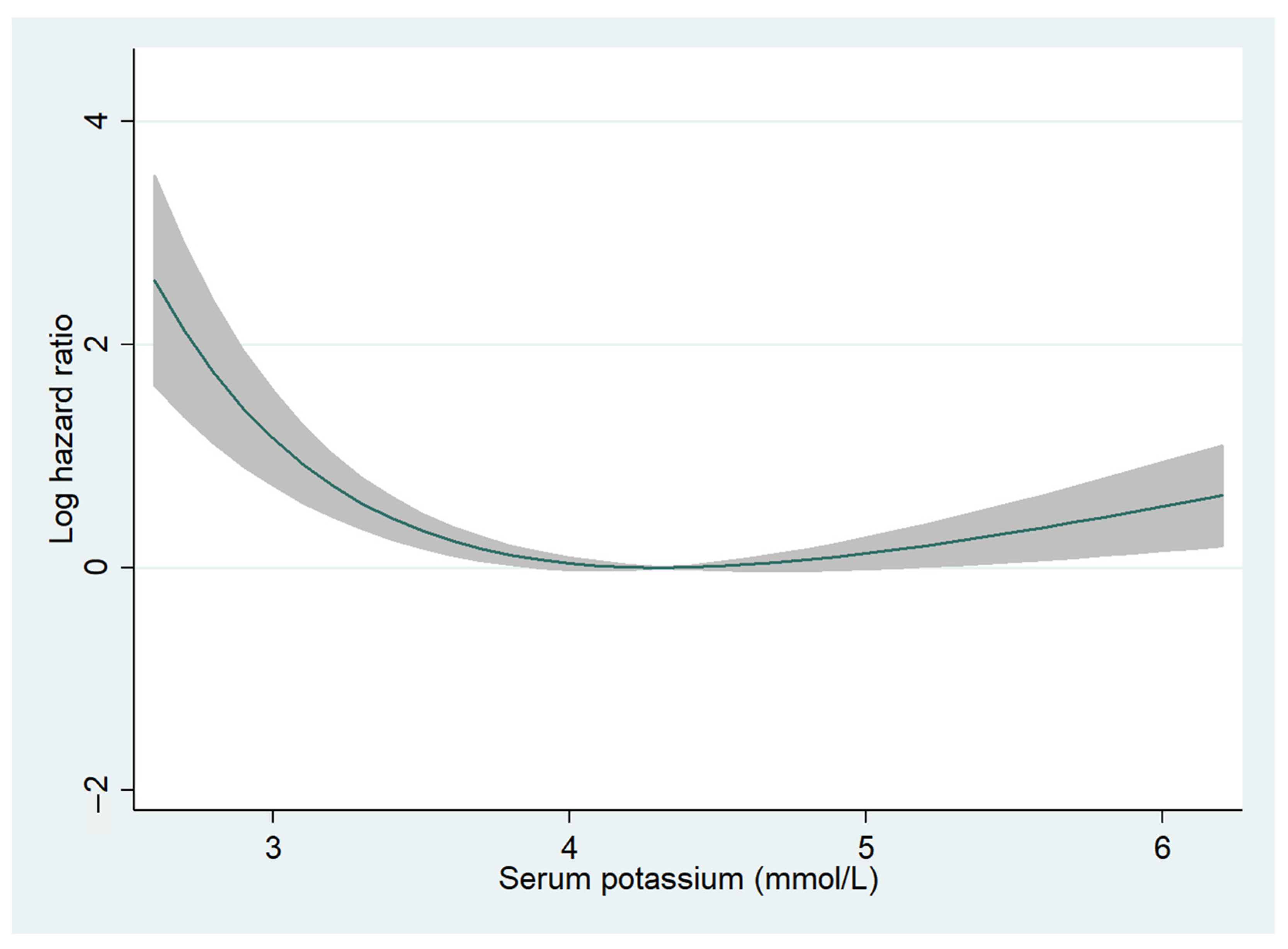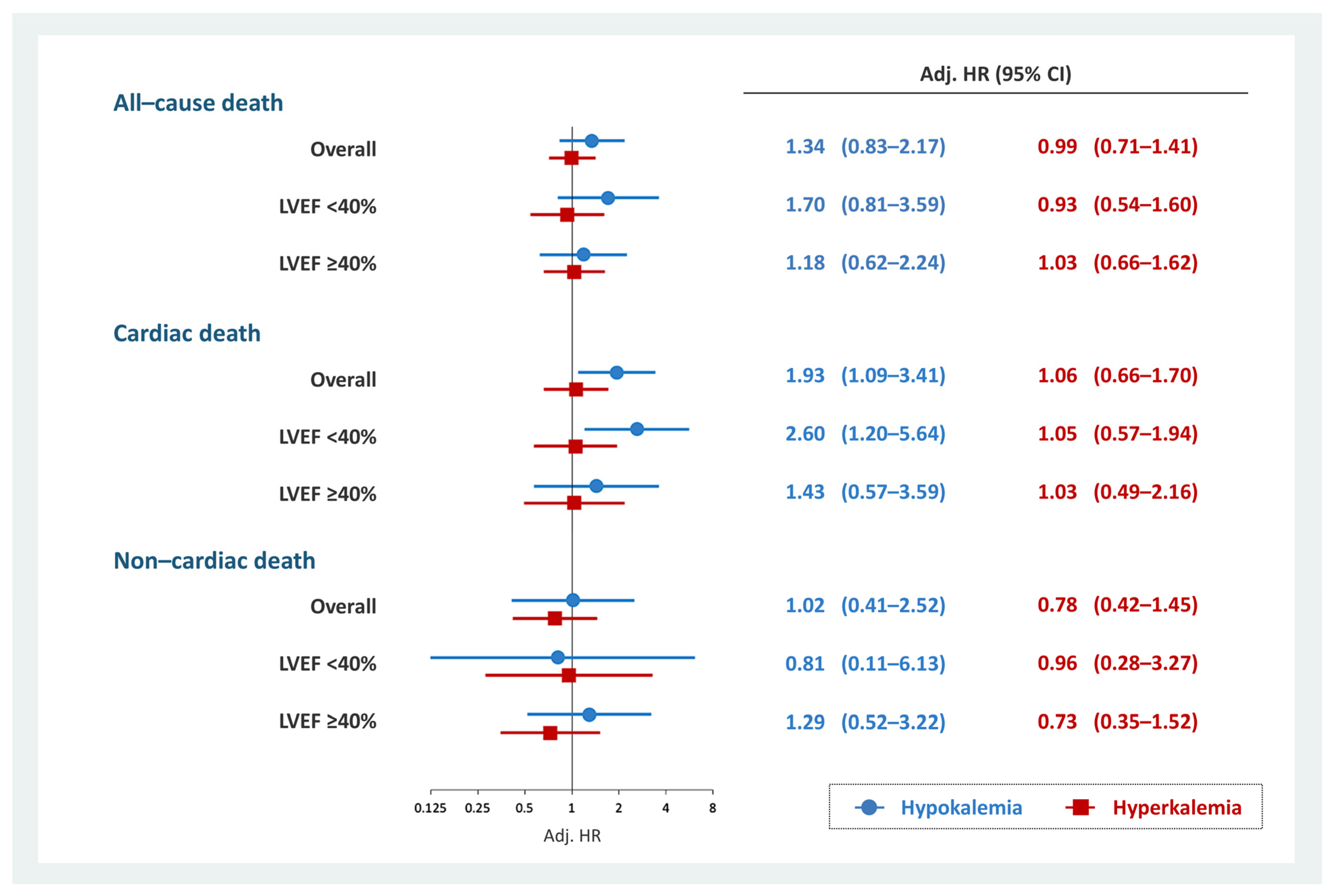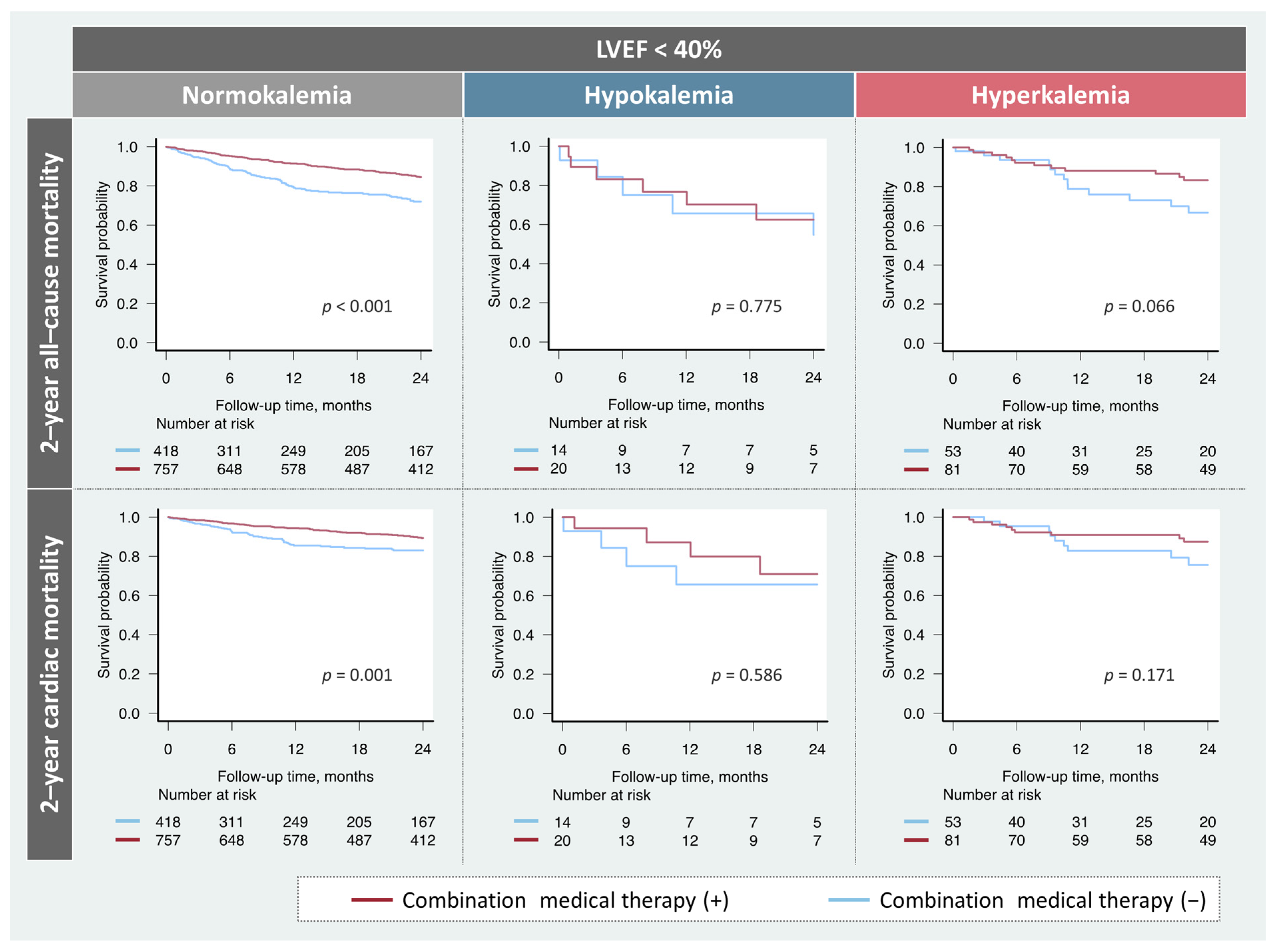Association of Potassium Level at Discharge with Long-Term Mortality in Hospitalized Patients with Heart Failure
Abstract
1. Introduction
2. Materials and Methods
2.1. Study Population and Protocol
2.2. Data Collection
2.3. Variable Definitions
2.4. Study Endpoints
2.5. Statistical Analysis
3. Results
3.1. Patients Characteristics
3.2. Association of Potassium with 2-Year Mortality
3.3. Prescription Rate and Impact of Combination Medical Therapy
4. Discussion
4.1. Differential Impact of Hypokalemia and Hyperkalemia on Prognosis
4.2. Patient Characteristics and Therapeutic Targets of Hypokalemia
4.3. Limitations
5. Conclusions
Supplementary Materials
Author Contributions
Funding
Institutional Review Board Statement
Informed Consent Statement
Data Availability Statement
Conflicts of Interest
References
- Palmer, B.F. Managing Hyperkalemia Caused by Inhibitors of the Renin–Angiotensin–Aldosterone System. N. Engl. J. Med. 2004, 351, 585–592. [Google Scholar] [CrossRef] [PubMed]
- Jain, N.; Kotla, S.; Little, B.B.; Weideman, R.A.; Brilakis, E.; Reilly, R.F.; Banerjee, S. Predictors of Hyperkalemia and Death in Patients With Cardiac and Renal Disease. Am. J. Cardiol. 2012, 109, 1510–1513. [Google Scholar] [CrossRef] [PubMed]
- Tromp, J.; ter Maaten, J.M.; Damman, K.; O’Connor, C.M.; Metra, M.; Dittrich, H.C.; Ponikowski, P.; Teerlink, J.R.; Cotter, G.; Davison, B.; et al. Serum Potassium Levels and Outcome in Acute Heart Failure (Data from the PROTECT and COACH Trials). Am. J. Cardiol. 2017, 119, 290–296. [Google Scholar] [CrossRef] [PubMed]
- Macdonald, J.E.; Struthers, A.D. What is the optimal serum potassium level in cardiovascular patients? J. Am. Coll. Cardiol. 2004, 43, 155–161. [Google Scholar] [CrossRef] [PubMed]
- Maggioni, A.P.; Anker, S.D.; Dahlström, U.; Filippatos, G.; Ponikowski, P.; Zannad, F.; Amir, O.; Chioncel, O.; Leiro, M.C.; Drozdz, J.; et al. Are hospitalized or ambulatory patients with heart failure treated in accordance with European Society of Cardiology guidelines? Evidence from 12 440 patients of the ESC Heart Failure Long-Term Registry. Eur. J. Heart Fail. 2013, 15, 1173–1184. [Google Scholar] [CrossRef]
- McDonagh, T.A.; Metra, M.; Adamo, M.; Gardner, R.S.; Baumbach, A.; Böhm, M.; Burri, H.; Butler, J.; Čelutkienė, J.; Chioncel, O.; et al. 2021 ESC Guidelines for the diagnosis and treatment of acute and chronic heart failure. Eur. Heart J. 2021, 42, 3599–3726. [Google Scholar] [CrossRef]
- Heidenreich, P.A.; Bozkurt, B.; Aguilar, D.; Allen, L.A.; Byun, J.J.; Colvin, M.M.; Deswal, A.; Drazner, M.H.; Dunlay, S.M.; Evers, L.R.; et al. 2022 AHA/ACC/HFSA Guideline for the Management of Heart Failure: A Report of the American College of Cardiology/American Heart Association Joint Committee on Clinical Practice Guidelines. Circulation 2022, 145, e895–e1032. [Google Scholar] [CrossRef]
- Núñez, J.; Bayés-Genís, A.; Zannad, F.; Rossignol, P.; Núñez, E.; Bodí, V.; Miñana, G.; Santas, E.; Chorro, F.J.; Mollar, A.; et al. Long-Term Potassium Monitoring and Dynamics in Heart Failure and Risk of Mortality. Circulation 2018, 137, 1320–1330. [Google Scholar] [CrossRef]
- Linde, C.; Qin, L.; Bakhai, A.; Furuland, H.; Evans, M.; Ayoubkhani, D.; Palaka, E.; Bennett, H.; McEwan, P. Serum potassium and clinical outcomes in heart failure patients: Results of risk calculations in 21 334 patients in the UK. ESC Heart Fail. 2019, 6, 280–290. [Google Scholar] [CrossRef]
- Cooper, L.B.; Benson, L.; Mentz, R.J.; Savarese, G.; Devore, A.D.; Carrero, J.; Dahlström, U.; Anker, S.D.; Lainscak, M.; Hernandez, A.F.; et al. Association between potassium level and outcomes in heart failure with reduced ejection fraction: A cohort study from the Swedish Heart Failure Registry. Eur. J. Heart Fail. 2020, 22, 1390–1398. [Google Scholar] [CrossRef]
- Ferreira, J.P.; Butler, J.; Rossignol, P.; Pitt, B.; Anker, S.D.; Kosiborod, M.; Lund, L.H.; Bakris, G.L.; Weir, M.R.; Zannad, F. Abnormalities of Potassium in Heart Failure. J. Am. Coll. Cardiol. 2020, 75, 2836–2850. [Google Scholar] [CrossRef] [PubMed]
- Shiraishi, Y.; Kohsaka, S.; Abe, T.; Mizuno, A.; Goda, A.; Izumi, Y.; Yagawa, M.; Akita, K.; Sawano, M.; Inohara, T.; et al. Validation of the Get With The Guideline–Heart Failure risk score in Japanese patients and the potential improvement of its discrimination ability by the inclusion of B-type natriuretic peptide level. Am. Heart J. 2016, 171, 33–39. [Google Scholar] [CrossRef] [PubMed]
- Ho, K.K.; Anderson, K.M.; Kannel, W.B.; Grossman, W.; Levy, D. Survival after the onset of congestive heart failure in Framingham Heart Study subjects. Circulation 1993, 88, 107–115. [Google Scholar] [CrossRef] [PubMed]
- Krück, F.; Bablok, W.; Besenfelder, E.; Betzien, G.; Kaufmann, B. Clinical and pharmacological investigations of the new saluretic azosemid. Eur. J. Clin. Pharmacol. 1978, 14, 153–161. [Google Scholar] [CrossRef]
- Rahhal, A.; Saad, M.O.; Tawengi, K.; Assi, A.A.R.; Habra, M.; Ahmed, D. Torsemide versus furosemide after acute decompensated heart failure: A retrospective observational study. BMC Cardiovasc. Disord. 2019, 19, 127. [Google Scholar] [CrossRef]
- Okabe, T.; Yakushiji, T.; Kido, T.; Oyama, Y.; Igawa, W.; Ono, M.; Ebara, S.; Yamashita, K.; Yamamoto, M.H.; Saito, S.; et al. The association between high-dose loop diuretic use at discharge and cardiovascular mortality in patients with heart failure. ESC Heart Fail. 2017, 5, 87–94. [Google Scholar] [CrossRef]
- Lombardi, C.M.; Carubelli, V.; Peveri, G.; Inciardi, R.M.; Pagnesi, M.; Ravera, A.; Tomasoni, D.; Garafa, E.; Oriecuia, C.; Specchia, C.; et al. Prognostic significance of serum potassium in patients hospitalized for acute heart failure. ESC Heart Fail. 2022, 9, 2357–2366. [Google Scholar] [CrossRef]
- Mefford, M.T.; Koyama, S.Y.; De Jesus, J.; Wei, R.; Fischer, H.; Harrison, T.N.; Woo, P.; Reynolds, K. Representativeness of the GALACTIC-HF Clinical Trial in Patients Having Heart Failure With Reduced Ejection Fraction. J. Am. Heart Assoc. 2022, 11, e023766. [Google Scholar] [CrossRef]
- Kajimoto, K.; Minami, Y.; Sato, N.; Kasanuki, H. Etiology of Heart Failure and Outcomes in Patients Hospitalized for Acute Decompensated Heart Failure With Preserved or Reduced Ejection Fraction. Am. J. Cardiol. 2016, 118, 1881–1887. [Google Scholar] [CrossRef]
- Iorio, A.; Senni, M.; Barbati, G.; Greene, S.J.; Poli, S.; Zambon, E.; Di Nora, C.; Cioffi, G.; Tarantini, L.; Gavazzi, A.; et al. Prevalence and prognostic impact of non-cardiac co-morbidities in heart failure outpatients with preserved and reduced ejection fraction: A community-based study. Eur. J. Heart Fail. 2018, 20, 1257–1266. [Google Scholar] [CrossRef]
- Higuchi, S.; Kohno, T.; Kohsaka, S.; Shiraishi, Y.; Takei, M.; Goda, A.; Shoji, S.; Nagatomo, Y.; Yoshikawa, T. Different Impact of Beta-Blockers on Long-Term Mortality in Heart Failure Patients with and without Chronic Obstructive Pulmonary Disease. J. Clin. Med. 2021, 10, 4378. [Google Scholar] [CrossRef] [PubMed]
- Hicks, K.A.; Tcheng, J.E.; Bozkurt, B.; Chaitman, B.R.; Cutlip, D.E.; Farb, A.; Fonarow, G.C.; Jacobs, J.P.; Jaff, M.R.; Lichtman, J.H.; et al. 2014 ACC/AHA Key Data Elements and Definitions for Cardiovascular Endpoint Events in Clinical Trials: A Report of the American College of Cardiology/American Heart Association Task Force on Clinical Data Standards (Writing Committee to Develop Cardiovascular Endpoints Data Standards). J. Am. Coll. Cardiol. 2015, 66, 403–469. [Google Scholar] [CrossRef] [PubMed]
- Fukuoka, R.; Kohno, T.; Kohsaka, S.; Shiraishi, Y.; Sawano, M.; Abe, T.; Nagatomo, Y.; Goda, A.; Mizuno, A.; Fukuda, K.; et al. Prediction of sudden cardiac death in Japanese heart failure patients: International validation of the Seattle Proportional Risk Model. EP Eur. 2020, 22, 588–597. [Google Scholar] [CrossRef]
- Kanda, Y. Investigation of the freely available easy-to-use software ‘EZR’ for medical statistics. Bone Marrow Transplant. 2013, 48, 452–458. [Google Scholar] [CrossRef] [PubMed]
- Aldahl, M.; Jensen, A.-S.C.; Davidsen, L.; Eriksen, M.A.; Hansen, S.M.; Nielsen, B.J.; Krogager, M.; Køber, L.; Torp-Pedersen, C.; Søgaard, P. Associations of serum potassium levels with mortality in chronic heart failure patients. Eur. Heart J. 2017, 38, 2890–2896. [Google Scholar] [CrossRef]
- Basnet, S.; Dhital, R.; Tharu, B.; Ghimire, S.; Poudel, D.R.; Donato, A. Influence of abnormal potassium levels on mortality among hospitalized heart failure patients in the US: Data from National Inpatient Sample. J. Community Hosp. Intern. Med. Perspect. 2019, 9, 103–107. [Google Scholar] [CrossRef]
- Nishihara, T.; Tokitsu, T.; Sueta, D.; Takae, M.; Oike, F.; Fujisue, K.; Usuku, H.; Takashio, S.; Hanatani, S.; Kanazawa, H.; et al. Serum Potassium and Cardiovascular Events in Heart Failure With Preserved Left Ventricular Ejection Fraction Patients. Am. J. Hypertens. 2018, 31, 1098–1105. [Google Scholar] [CrossRef]
- Abdelhamid, M.; Rosano, G.; Metra, M.; Adamopoulos, S.; Böhm, M.; Chioncel, O.; Filippatos, G.; Jankowska, E.A.; Lopatin, Y.; Lund, L.; et al. Prevention of sudden death in heart failure with reduced ejection fraction: Do we still need an implantable cardioverter-defibrillator for primary prevention? Eur. J. Heart Fail. 2022. [Google Scholar] [CrossRef]
- Palin, V.; Drozd, M.; Garland, E.; Malik, A.; Straw, S.; McGinlay, M.; Simms, A.; Gatenby, V.K.; Sengupta, A.; Levelt, E.; et al. Reduction of heart failure guideline-directed medication during hospitalization: Prevalence, risk factors, and outcomes. ESC Heart Fail. 2022, 9, 3298–3307. [Google Scholar] [CrossRef]
- Beusekamp, J.C.; Tromp, J.; van der Wal, H.H.; Anker, S.D.; Cleland, J.G.; Dickstein, K.; Filippatos, G.; van der Harst, P.; Hillege, H.L.; Lang, C.C.; et al. Potassium and the use of renin-angiotensin-aldosterone system inhibitors in heart failure with reduced ejection fraction: Data from BIOSTAT-CHF. Eur. J. Heart Fail. 2018, 20, 923–930. [Google Scholar] [CrossRef]
- Rossignol, P.; Lainscak, M.; Crespo-Leiro, M.G.; Laroche, C.; Piepoli, M.F.; Filippatos, G.; Rosano, G.M.C.; Savarese, G.; Anker, S.D.; Seferovic, P.M.; et al. Unravelling the interplay between hyperkalaemia, renin–angiotensin–aldosterone inhibitor use and clinical outcomes. Data from 9222 chronic heart failure patients of the ESC-HFA-EORP Heart Failure Long-Term Registry. Eur. J. Heart Fail. 2020, 22, 1378–1389. [Google Scholar] [CrossRef] [PubMed]
- Pezhouman, A.; Singh, N.; Song, Z.; Nivala, M.; Eskandari, A.; Cao, H.; Bapat, A.; Ko, C.Y.; Nguyen, T.; Qu, Z.; et al. Molecular Basis of Hypokalemia-Induced Ventricular Fibrillation. Circulation 2015, 132, 1528–1537. [Google Scholar] [CrossRef] [PubMed]
- Weiss, J.N.; Qu, Z.; Shivkumar, K. Electrophysiology of Hypokalemia and Hyperkalemia. Circ. Arrhythmia Electrophysiol. 2017, 10. [Google Scholar] [CrossRef] [PubMed]
- Tannen, R.L. Diuretic-induced hypokalemia. Kidney Int. 1985, 28, 988–1000. [Google Scholar] [CrossRef][Green Version]
- Beusekamp, J.C.; Teng, T.K.; Tay, W.T.; Ouwerkerk, W.; Richards, A.M.; Anand, I.S.; Chopra, V.K.; Wander, G.S.; van der Meer, P.; Voors, A.A.; et al. Potassium abnormalities in patients with heart failure from 11 Asian regions: Insights from the ASIAN-HF registry. Eur. J. Heart Fail. 2019, 22, 751–754. [Google Scholar] [CrossRef]
- Higuchi, S.; Orban, M.; Adamo, M.; Giannini, C.; Melica, B.; Karam, N.; Praz, F.; Kalbacher, D.; Koell, B.; Stolz, L.; et al. Guideline-directed medical therapy in patients undergoing transcatheter edge-to-edge repair for secondary mitral regurgitation. Eur. J. Heart Fail. 2022. [Google Scholar] [CrossRef]
- Dewan, P.; Jhund, P.S.; Shen, L.; Petrie, M.C.; Abraham, W.T.; Ali, M.A.; Chen, C.; Desai, A.S.; Dickstein, K.; Huang, J.; et al. Heart failure with reduced ejection fraction: Comparison of patient characteristics and clinical outcomes within Asia and between Asia, Europe and the Americas. Eur. J. Heart Fail. 2019, 21, 577–587. [Google Scholar] [CrossRef]



| All (n = 3398) | Hypokalemia (n = 115) | Normokalemia (n = 2960) | Hyperkalemia (n = 323) | p Value | |
|---|---|---|---|---|---|
| Age, years | 74 ± 13 | 77 ± 13 | 74 ± 13 | 75 ± 12 | 0.015 |
| Female, n (%) | 1360 (40) | 58 (50) | 1191 (40) | 111 (34) | 0.008 |
| Hypertension, n (%) | 2225 (65) | 76 (66) | 1928 (65) | 221 (68) | 0.501 |
| Dyslipidemia, n (%) | 1294 (38) | 41 (36) | 1127 (38) | 126 (39) | 0.819 |
| Diabetes Mellitus, n (%) | 1128 (33) | 33 (29) | 969 (33) | 126 (39) | 0.047 |
| History of HF, n (%) | 999 (29) | 54 (47) | 852 (29) | 93 (29) | <0.001 |
| COPD, n (%) | 163 (5) | 4 (3) | 141 (5) | 18 (6) | 0.716 |
| Stroke, n (%) | 446 (13) | 18 (16) | 386 (13) | 42 (13) | 0.656 |
| LVEF, % | 45 ± 15 | 47 ± 14 | 45 ± 15 | 44 ± 15 | 0.174 |
| LVEF <40%, n (%) | 1344 (40) | 34 (30) | 1175 (40) | 134 (41) | 0.059 |
| Etiologies of heart failure | |||||
| IHD, n (%) | 971 (29) | 26 (23) | 843 (28) | 102 (32) | 0.183 |
| DCM, n (%) | 486 (14) | 7 (6) | 430 (15) | 49 (15) | 0.025 |
| VHD, n (%) | 889 (26) | 39 (34) | 778 (26) | 72 (22) | 0.049 |
| Others, n (%) | 1052 (31) | 43 (37) | 909 (31) | 100 (31) | 0.314 |
| AF/AFL, n (%) | 1706 (50) | 62 (54) | 1501 (51) | 143 (44) | 0.189 |
| Pacemaker, n (%) | 264 (8) | 13 (11) | 231 (8) | 20 (6) | 0.217 |
| ICD, n (%) | 124 (4) | 8 (7) | 103 (3) | 13 (4) | 0.137 |
| CRT, n (%) | 58 (2) | 4 (3) | 47 (2) | 7 (2) | 0.166 |
| Status at discharge | |||||
| Body mass index, kg/m2 | 22 ± 4 | 21 ± 4 | 22 ± 4 | 21 ± 4 | 0.005 |
| Systolic blood pressure, mmHg | 112 ± 17 | 116 ± 19 | 112 ± 17 | 111 ± 18 | 0.019 |
| Diastolic blood pressure, mmHg | 62 ± 11 | 63 ± 13 | 61 ± 11 | 62 ± 12 | 0.345 |
| Heart rate, bpm | 71 ± 13 | 73 ± 14 | 71 ± 12 | 71 ± 13 | 0.122 |
| NYHA III/IV, n (%) | 701 (21) | 38 (33) | 589 (20) | 74 (23) | 0.002 |
| Cachexia, n (%) | 759 (22) | 38 (33) | 645 (22) | 76 (24) | 0.012 |
| Laboratory data at discharge | |||||
| Hemoglobin, g/dL | 12.2 ± 2.2 | 11.5 ± 2.0 | 12.2 ± 2.1 | 12.2 ± 2.4 | 0.003 |
| eGFR, mL/min/1.73 m2 | 51.0 (36.2–64.6) | 55.4 (35.9–67.1) | 51.8 (37.4–65.5) | 40.5 (28.8–55.0) | <0.001 |
| Albumin, g/dL | 3.5 ± 0.5 | 3.3 ± 0.5 | 3.5 ± 0.5 | 3.5 ± 0.5 | <0.001 |
| Sodium, mEq/L | 139 ± 4 | 140 ± 4 | 139 ± 3 | 137 ± 4 | <0.001 |
| Potassium, mEq/L | 4.3 ± 0.5 | 3.2 ± 0.2 | 4.3 ± 0.4 | 5.3 ± 0.4 | <0.001 |
| Medication at discharge | |||||
| Combination medical therapy, n (%) | 1740 (51) | 46 (40) | 1522 (51) | 172 (53) | 0.041 |
| RAS-I, n (%) | 2170 (64) | 63 (55) | 1891 (64) | 216 (67) | 0.069 |
| Beta-blockers, n (%) | 2609 (77) | 78 (68) | 2275 (77) | 256 (79) | 0.042 |
| MRA, n (%) | 1213 (36) | 42 (37) | 1076 (36) | 95 (29) | 0.042 |
| Loop diuretics, n (%) | 2621 (77) | 90 (78) | 2296 (78) | 235 (73) | 0.136 |
| Furosemide equivalent dose, mg | 20 (20–40) | 40 (20–40) | 20 (20–40) | 20 (20–40) | <0.001 |
| High-dose loop diuretics, n (%) | 276 (8) | 19 (17) | 239 (8) | 18 (6) | 0.004 |
| Thiazide diuretics, n (%) | 244 (7) | 18 (16) | 210 (7) | 16 (5) | 0.002 |
Publisher’s Note: MDPI stays neutral with regard to jurisdictional claims in published maps and institutional affiliations. |
© 2022 by the authors. Licensee MDPI, Basel, Switzerland. This article is an open access article distributed under the terms and conditions of the Creative Commons Attribution (CC BY) license (https://creativecommons.org/licenses/by/4.0/).
Share and Cite
Miura, Y.; Higuchi, S.; Kohno, T.; Shiraishi, Y.; Kitamura, M.; Nagatomo, Y.; Takei, M.; Nakano, S.; Goda, A.; Soejima, K.; et al. Association of Potassium Level at Discharge with Long-Term Mortality in Hospitalized Patients with Heart Failure. J. Clin. Med. 2022, 11, 7358. https://doi.org/10.3390/jcm11247358
Miura Y, Higuchi S, Kohno T, Shiraishi Y, Kitamura M, Nagatomo Y, Takei M, Nakano S, Goda A, Soejima K, et al. Association of Potassium Level at Discharge with Long-Term Mortality in Hospitalized Patients with Heart Failure. Journal of Clinical Medicine. 2022; 11(24):7358. https://doi.org/10.3390/jcm11247358
Chicago/Turabian StyleMiura, Yusuke, Satoshi Higuchi, Takashi Kohno, Yasuyuki Shiraishi, Mitsunobu Kitamura, Yuji Nagatomo, Makoto Takei, Shintaro Nakano, Ayumi Goda, Kyoko Soejima, and et al. 2022. "Association of Potassium Level at Discharge with Long-Term Mortality in Hospitalized Patients with Heart Failure" Journal of Clinical Medicine 11, no. 24: 7358. https://doi.org/10.3390/jcm11247358
APA StyleMiura, Y., Higuchi, S., Kohno, T., Shiraishi, Y., Kitamura, M., Nagatomo, Y., Takei, M., Nakano, S., Goda, A., Soejima, K., Kohsaka, S., & Yoshikawa, T., on behalf of the West Tokyo Heart Failure (WET-HF) Registry Investigators. (2022). Association of Potassium Level at Discharge with Long-Term Mortality in Hospitalized Patients with Heart Failure. Journal of Clinical Medicine, 11(24), 7358. https://doi.org/10.3390/jcm11247358







